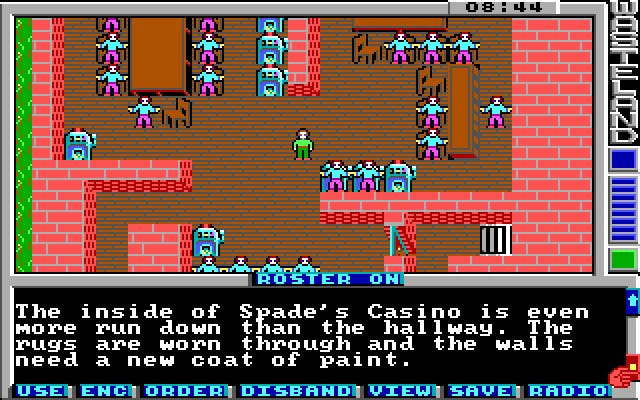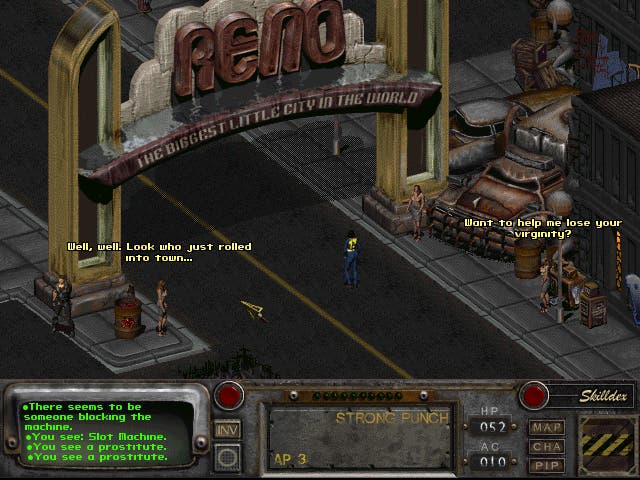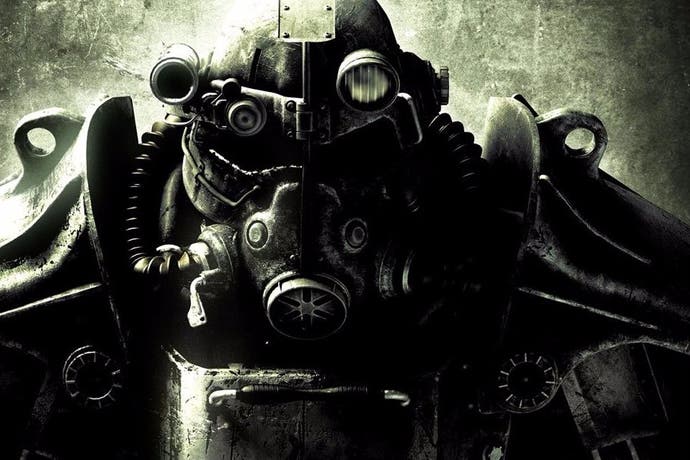A brief history of Fallout
War. War changes quite a lot.
After years of waiting and false hopes, Bethesda has finally announced Fallout 4. It's as good an excuse as any to take a trip through time to where it all began, in a very different kind, but now much more familiar kind of Wasteland. This was back in 1988, on technology so primitive that most of the original's game text had to be printed in a manual, with the game simply giving a number to look up every time anything happened. Nevertheless, it found almost instant critical and commercial success... and immense difficulty getting a sequel off the ground. At least, an official one.
Wasteland offers a very different flavour of apocalypse to the Fallout games. It's more focused on science-fiction concepts, such as robots and problematic AI, and has its tongue planted much more firmly in its cheek. The first town, Highpool, offers such delights as packs of wandering juveniles and a river that's easy to slip in while exploring. Getting in a fight and killing kids will summon a cowboy called Red Ryder to try and take you out. Leaving town and heading for the nearby Ag Center meanwhile and you're no safer, just more likely to be killed by killer rabbits straight out of Monty Python. The whole game wasn't so silly, but it definitely had its moments. Unlike Fallout, a solo game with optional companions to tag along and often shoot you in the back with an Uzi, it was also a party based game. As was the style, you had a team of four Desert Rangers setting out to try and bring law and order to both the oppressed and the unrighteous - a role that came with expectations and a sense of duty rather than simply the lust for cash and upgrades. It was also extremely ambitious for the time, with encounters that could be solved in different ways with different skills, and a world that didn't just casually reset itself once the Rangers left town. If things went wrong, they stayed wrong.

A sequel seemed inevitable, and there was one, after a fashion. It was called Fountain of Dreams (1990), and nobody involved with the first game worked on it. Really, only EA has ever tried to really push it as the follow-up, and even it gave up quite early on. It takes place in post-apocalyptic Florida, meaning a greener apocalypse. It also cranked up Wasteland's insanity to whole new levels, even using the slogan "The world is crazy. Too bad you're sane." For starters, there's an entire faction of clowns. Yes, clowns. Killer clowns who actually control much of the known world. "The Clowns have perverted the slapstick humour of their forefathers, taking its feigned violence literally, and expanding it into the martial art Slap-Fu." There's a voodoo faction, with characters like Lupe Garoo happy to set werewolves on your party. Walk into a fountain, and chances are good you'll be told "It's full of savage piranha." This was just the start of the silliness.
Fountain of Dreams was quickly forgotten, and eventually even EA finally admitted it was no more a Wasteland sequel than Postal 3 was the long-awaited follow-up to Beyond Good And Evil. It does arguably deserve one accolade though, for being one of the smallest RPGs ever made. The map is about the size of a tutorial zone, with the game stretched out by its brutality rather than content. Your quest is to find a magical fountain with the ability to cure mutations (its one good idea is that your characters build them up and have to juggle the benefits of their powers versus getting them treated). That fountain turns out to be about 20 steps away from your starting position. Nothing else could so neatly sum up the pointlessness of the journey.
The Wasteland engine did get another outing in the strange (and deeply misogynistic) Escape from Hell, a game memorable for moments like recruiting Stalin to help you fight Hitler in an 8-bit Dachau. The original creators at Interplay however moved on to another project, Meantime. This was going to be a time-travel RPG along the lines of Bill and Ted's Excellent Adventure, only with more XP points and less air guitar. It was cancelled in development though, and an early 90s revival cut-short by the arrival of Ultima VII - still one of the best RPGs ever made, and a stunning showpiece of both graphics and systems at the time.
Which brings us to 1997's Fallout. Interplay didn't have the rights to Wasteland, so it had to be a spiritual successor with its own distinct flavour - a cocktail of 1950s hopes and paranoia immediately established with the Ink Spots crooning "Maybe" and that now echoing phrase "War. War never changes." Fallout spent most of its development flying the flag for Steve Jackson's GURPS system, though by the time it actually landed, arguments over the violence planned for Fallout had forced a change to the homebrew SPECIAL system instead - an acronym standing for Strength, Perception, Endurance, Charisma, Agility, Intelligence and Luck. These basic stats both controlled in-game stat checks (most memorably, the series' alternate dialogue for characters barely capable of conscious thought) and the effect of other character traits and perks.

Interplay didn't think too much of Fallout during most of its development, while it was simply called "V13" - Vault 13 of course being the main character's home, safe from the mutations outside. This slowly changed as development finished, with talent like Ron Perlman being brought on board for voiceover duties, a complex combat system that let you directly target and shoot enemies in the ol' blood sausage, and a name change - first to Armageddon, then to the second choice, Fallout, when that name seemed impossible.
The box asked "Remember Wasteland?", but it wasn't long before the original was pushed firmly back into the vaults by its spiritual successor - a much deeper world, a far better skill system and, most notably, a level of maturity that allowed for a villain who could be talked out of their plan, and one of gaming's most notable downer endings. Having saved both their home Vault and the whole Wasteland, our hero returns home only to be told that they're too corrupted to be allowed back in and are cast back out into the wilds.
Fallout was a huge critical hit, though as is often the case, didn't sell particularly well. Still, Interplay wasted no time carving off its developers into Black Isle Studios and commissioning a sequel. Fallout 2 only got about a year and a half development, landing in 1998. It was bigger, it was mostly better, and it went out of its way to satiate fan demands. No time-limit on the main quest. The ability to shove characters out of the way. Far more involved locations, most notably New Reno, where characters could get involved in mob politics or become a porn-star that would have every other person they met screaming "Look! It's Arnold Swollenmember!" This was 80 years after the original game, and a more civilised wasteland... for good and bad. Quests happily played with sex and drugs and violent crime, as well as an absolute overdose of pop-culture references mocking everything from Scientology to Star Trek to having players find Monty Python's Bridge of Death.

While fun at the time, it's now largely agreed that this was over the top and detracted considerably from the mood. Their inclusion does however speak to a big problem with development - everyone was doing their little corners of the game without any real idea of what everyone else was up to. Key team members like original designer Tim Cain jumped ship to form Troika Games (makers of Arcanum, which took the Fallout style into a world where fantasy met technology, and the beloved Vampire: The Masquerade: Bloodlines), and the chaotic development led to a release that wasn't so much buggy as held together by squished bug guts.
Again, the game was embraced by fans, but not as big a success as its reputation hints at. And then, things start to get complicated. The next Fallout game wouldn't be until 2001, a turn-based strategy offering called Tactics: Brotherhood of Steel. It wasn't a bad game, but it wasn't an RPG and so didn't really scratch the itch. It still did better than Fallout: Brotherhood of Steel in 2004 - a terrible action RPG for Xbox and Playstation 2. We gave it 3/10 back in the Age of Scores, calling it "a disaster of nuclear meltdown proportions".
The 'real' Fallout 3, codenamed Van Buren, was kept secret for many years, until a tech demo leaked onto the net in 2007. It was a 3D based game rather than using the old engine, in which the player began as a prisoner caught between assorted power groups like the militaristic Caesar's Legion and Fallout 2's New California Republic around landmarks like the Hoover Dam. If that sounds familiar, it's because much of Black Isle's staff ended up at Obsidian Entertainment. Fallout: New Vegas didn't follow the Van Buren plot (a quest to stop an rogue scientist nuking the world again), but it did borrow and build on a number of the ideas intended for it. Caesar's Legion for instance became a dominate power, rather than a smaller group with a direct rival in the shape of the Daughters of Hecate - a mirroring matriarchal group of slavers and tribals.
By 2004 though, Interplay was out of money. Van Buren had already been cancelled and the team laid off, but now it had no choice but to try and sell its licenses. Enter Bethesda, which paid just under $6 million for Fallout and created an unusual situation where they were making Fallout 3 while Interplay tried in vain to create a Fallout Online MMO. Bad blood quickly began splashing over Interplay selling the previous games on digital distribution and Bethesda claiming that Interplay wasn't doing the 'full scale' development of Fallout Online that their agreements promised. This led to a strange case where Bethesda was suing Interplay for using Fallout elements like names and locations in their Fallout Online game, while Interplay pointed out that it's hard to make a multiplayer game in a series that you're not allowed to reference. Eventually a cheque for a couple of million dollars simplified it all when Interplay just sold the Online rights to Bethesda in 2012.
(At this point, the remnants Interplay made one final push to get a Fallout type game off the ground with "Project V13" and an attempt to crowdfund a Black Isle revival, though one minus all the actual people that might have made that compelling. At a time when others were able to promise "We'll make Wasteland 2!" and "Have another Divinity game!", even hardcore fans weren't particularly enthused about giving the company money just to make a tech demo to try and attract interest. Paying $20 for access to a developer forum didn't exactly sweeten the pot. The attempt now looks to be dead, though Interplay itself still hangs on)
All this brought Fallout into the Age of Bethesda - a 3D Fallout based on the same technology as The Elder Scrolls, but with a few tweaks to keep to the original games' strengths. Most notably, while combat could be done in real time, it was geared around a system called VATS that would let characters pause to call shots and target weak spots. It did however change most of the world's vibe. The 50s atmosphere was present in the music and occasional encounters, but Bethesda's wasteland was a far less restored world than Fallout 2, despite being set centuries after the war. Corpses everywhere, broken mirrors, trash piled high; everyone just seemed to be stumbling around in denial, with few attempts to build anything more than a scavenger civilisation in the generations since. Love or hate it though, its style (and console release) made it the first huge success for the series. It outsold the prior games almost immediately, shipping 5 million copies in 2008.

Two years later, the spirit of Black Isle's Fallout returned when Bethesda had Obsidian create a spin-off - New Vegas. As well as the elements borrowed from Van Buren, it had people like J.E Sawyer and Chris Avellone who had worked on (amongst others) the past games. It also had no problem shipping five million copies early on, and most agree that its writing and world design was a solid step up from the original - though at the cost of extreme bugginess and a few obvious cases where development was hobbled by console limitations (the titular New Vegas being a big example, with its huge gates segmenting the Strip.) Unfortunately Obsidian didn't get to benefit much from this, having signed a contract based on Metacritic averages that only saw them get royalties if they got an 85+ average on Metacritic. Fallout: New Vegas got an average of 84.
Which brings us - pausing to nod respectfully at Wasteland 2, which arrived last year care of Brian Fargo's inXile - to now. Curiously, inXile - via a company called Roxy Friday - was seen trademarking a couple of the names you've seen here back at the end of 2014: Van Buren and Meantime. So far, Fargo's only comments have been "The (RPG Codex) investigative unit strikes again" and "Those sure sounds like interesting concepts to me." If plans are in motion though, we're not likely to hear about them for a while. For now, inXile has its hands full with Torment: Tides of Numenara and the upcoming Kickstarter for The Bard's Tale 4. Later this year though, who knows? Meantime's concept especially is still fresh, and the idea of a time-travelling RPG with modern narrative and graphics technologies is one well worth salivating over until your keyboard makes splashing sounds.
As for Fallout 4 though, we finally have confirmation that it's coming, and that it appears to be set in Boston, Massachusetts. Beyond that, though, there are countless questions and our first, in-depth look comes at Bethesda's E3 conference on June 14th, when we're sure to find out plenty more.


